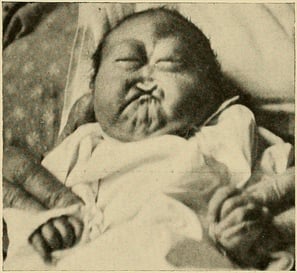Patau Syndrome
Patau syndrome, also known as trisomy 13, is a rare but severe genetic disorder caused by an extra copy of chromosome 13. This condition leads to multiple developmental abnormalities, often affecting various organs and structures in the body. Sadly, it carries a high mortality rate, with many affected infants not surviving beyond the first few weeks of life.
CONGENITALGENETIC
Rishwin A R
2/24/20252 min read


Causes of Patau Syndrome
Patau syndrome is primarily caused by a chromosomal abnormality where an individual has three copies of chromosome 13 instead of the usual two. This extra genetic material disrupts normal development, leading to severe congenital disabilities. The main types of trisomy 13 include:
Full Trisomy 13: Every cell in the body has an extra chromosome 13. This is the most common and severe form.
Mosaic Trisomy 13: Some cells have the extra chromosome, while others do not, leading to a milder presentation.
Partial Trisomy 13: Only a section of chromosome 13 is duplicated, which can cause varying symptoms depending on the size and location of the extra material.
Risk Factors of Patau syndrome
Maternal age: Advanced maternal age (above 35 years) increases the risk of trisomy conditions, including Patau syndrome.
Genetic predisposition: Though rare, parents with chromosomal rearrangements can pass on the disorder.
Environmental factors: While no specific environmental causes have been identified, genetic errors during cell division play a crucial role.
Symptoms of Patau Syndrome
The symptoms of Patau syndrome are often severe and affect multiple organ systems. Common signs include:
Physical Features
Cleft lip and palate: A split in the upper lip and/or the roof of the mouth.
Microcephaly: Abnormally small head size.
Low-set ears: Ears positioned lower than usual.
Polydactyly: Extra fingers or toes.
Small or missing eyes (microphthalmia/anophthalmia).
Neurological and Developmental Issues
Severe intellectual disability.
Seizures.
Poor muscle tone (hypotonia).
Organ Abnormalities
Congenital heart defects (e.g., ventricular septal defect, atrial septal defect).
Kidney malformations.
Brain defects (holoprosencephaly), where the brain fails to divide into two hemispheres properly.
Diagnosis of Patau Syndrome
Prenatal Screening and Diagnosis
Doctors can detect Patau syndrome before birth using:
Ultrasound: Detects structural abnormalities.
Non-invasive prenatal testing (NIPT): Analyzes fetal DNA in maternal blood.
Chorionic villus sampling (CVS) and amniocentesis: Provide a definitive genetic diagnosis.
Postnatal Diagnosis
If Patau syndrome is suspected after birth, doctors confirm it through:
Physical examination.
Chromosomal analysis (karyotyping).
Treatment and Management
Unfortunately, there is no cure for Patau syndrome. Treatment focuses on managing symptoms and improving the quality of life.
Supportive Care
Neonatal intensive care: Many infants require immediate medical attention at birth.
Feeding support: Babies with cleft palates may need specialized feeding techniques.
Surgery: Some congenital abnormalities, like heart defects and cleft lip, may be surgically corrected.
Palliative Care
Due to the high mortality rate, palliative care is often provided to ensure comfort and dignity for affected infants. This includes pain management, respiratory support, and parental guidance.
Prognosis and Life Expectancy
The prognosis for infants with Patau syndrome is generally poor. Most babies do not survive beyond the first few days or weeks due to severe complications. However, rare cases of children living beyond infancy have been reported, though they require extensive medical care.
Frequently Asked Questions (FAQs)
1. Can Patau syndrome be prevented?
Currently, there is no way to prevent Patau syndrome, but genetic counseling can help assess risks in future pregnancies.
2. Is Patau syndrome inherited?
Most cases are not inherited but occur due to random errors in cell division. However, some cases involving translocations can have a hereditary component.
3. How is Patau syndrome different from Down syndrome?
Both are chromosomal disorders, but Down syndrome (trisomy 21) is generally less severe, whereas Patau syndrome (trisomy 13) has more life-threatening complications.
4. Are there any treatments available for Patau syndrome?
No cure exists, but supportive and palliative care can help manage symptoms and provide comfort.
5. Can an affected baby survive to adulthood?
Survival beyond infancy is extremely rare, but some children with milder forms (like mosaic trisomy 13) have lived longer with medical support.
Syndromes.xyz
Explore medical syndromes and their details here.
For Educational purposes only
The information on this site is not in any way, replacement for professional advice. Always consult your physician regarding personal queries
Connect
Support
syndromesxyz@gmail.com
© 2024. All rights reserved.
